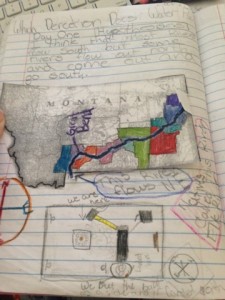Backwards Design Tool: One Teacher’s Journey and Process in NGSS
by MPRES Trainer Christine O’Shea
Using Essential Questions to drive instruction
I recently embarked on a unit design process with my first grade team at Hyalite Elementary’s first grade NGSS science units. We chose to use the Understanding by Design or sometimes called “backward design” lesson/unit planning. The goal is to teach for understanding and transfer of learning. This fits in nicely with how the framework outlines the core ideas, practices and crosscutting concepts.
The core ideas are best understood through the application of the crosscutting concepts and science and engineering practices. Our team went through the process of conceptual change (Phillips), whereby both children and adult learners went through a knowledge acquisition process where new information learned was different from learner’s prior beliefs, thus requiring a major modification of prior knowledge and new concepts.
Summary of this approach
The UBD or Understanding by Design (backward design) process starts with (stage 1) what you want students to walk away with. Critical thinking, creativity and the ability to work with others are key endpoints. You want students to understand and transfer their learning, not just tell what they know. Just because a student knows things does not mean they understand them.
Can you teach what you learned to someone else? Can you take what you learned and apply it to something else? A teacher will start the planning of their unit with what they want students to learn by the end of the lesson or unit. Then you look at evidence of student learning (stage 2). Then you determine what lessons/activities students need to experience as part of their learning, centered around guided, essential questions (stage 3).
Planning Assessment and Unit Activities (stages 2-3)
In planning of our units we started with (stage 1) the performance task: Use materials to design a solution to a human problem by mimicking how plants and/or animals use their external parts to help them survive, grow, and meet their needs. We took a look at this and then worked backwards to design a lesson that would give students the background knowledge and understanding to complete this task.
We then looked at the disciplinary core ideas in order to plan lessons and activities that would deepen student understanding of the major unit concepts. We created essential questions, student understandings, what students will be able to do and what students know centered around the core ideas. Some may find this process repetitive but it is worthwhile since it makes you think about end results in different ways.
The disciplinary ideas framed as essential questions would drive instruction in the entire unit. We sequenced lessons according to how they built upon one another. We knew that for students to create a solution to a human problem by applying their knowledge of plants and animal parts that we had to expose students to activities and media (books, internet, video) to lay the foundation of knowledge before they could apply that knowledge.
We started the unit by exposing students to information about plant and animal parts and their functions through various activities, hands-on observations, video, internet sites, research, etc. by focusing on our essential questions. We went from one question to another, taking notes along the way in our notebooks. I did not realize at the time (year 1), having been in the midst of my own conceptual change, that students were using the practice of: obtaining, evaluating and communicating information. This would lay the foundation of knowledge needed to do the performance task.
We knew that journaling and teacher observation during class activities would be used for formative assessment and the final performance task would serve as a final assessment. We discussed a pre- and post-assessment but saved that for later development.
Reflecting on our unit design
It wasn’t until later, in year two, that we truly figured how the practices and crosscutting concepts could be used to deepen student knowledge and understanding. Using the EQuIP (Educators Evaluating the Quality of Instructional Products) NGSS rubric helped us see the gaps in our unit plan. We used the rubric after teaching each unit. We realized certain content could be viewed through a crosscutting concept lens. In this case our lenses were patterns, cause and effect and structure and function.
Furthermore, we saw that the practices of constructing explanations and designing solutions and obtaining, evaluating and communicating information were integral to the unit. This was part of the conceptual change we went through as a grade level.
Three of us were involved with the MPRES course work. We found that many of our lesson activities were not suited to deepening student understanding or were one dimensional only. They were removed. We realized that we needed further work with our pre- and post-assessments, and a rubric for our student notebooks. Many lesson activities were taken out if they did not deepen student learning. We revised our unit plan, created pre- and post-assessments and a notebook rubric.
We realized that the process of developing lessons and a unit framed around NGSS was a yearly process of teaching, reflection, redesign, more reflection and redesign as our team went through the conceptual change process of understanding the three-tiered approach of NGSS with core concepts, practices and crosscutting concepts.
Cited Sources:
- McTighe, Jay and Wiggins, Grant. “Understanding by Design.” ASCD, 2008: https://www.fitnyc.edu/files/pdfs/Backward_design.pdf
- “Conceptual Change.” Encyclopedia of Educational Theory and Philosophy. Ed. D.C. Phillips. Thousand Oaks: Sage Publications, 2014. Credo Reference. Web. 9 October 2014.
